Maojun Zhang
Rethinking Multi-User Communication in Semantic Domain: Enhanced OMDMA by Shuffle-Based Orthogonalization and Diffusion Denoising
Jul 28, 2025



Abstract:Inter-user interference remains a critical bottleneck in wireless communication systems, particularly in the emerging paradigm of semantic communication (SemCom). Compared to traditional systems, inter-user interference in SemCom severely degrades key semantic information, often causing worse performance than Gaussian noise under the same power level. To address this challenge, inspired by the recently proposed concept of Orthogonal Model Division Multiple Access (OMDMA) that leverages semantic orthogonality rooted in the personalized joint source and channel (JSCC) models to distinguish users, we propose a novel, scalable framework that eliminates the need for user-specific JSCC models as did in original OMDMA. Our key innovation lies in shuffle-based orthogonalization, where randomly permuting the positions of JSCC feature vectors transforms inter-user interference into Gaussian-like noise. By assigning each user a unique shuffling pattern, the interference is treated as channel noise, enabling effective mitigation using diffusion models (DMs). This approach not only simplifies system design by requiring a single universal JSCC model but also enhances privacy, as shuffling patterns act as implicit private keys. Additionally, we extend the framework to scenarios involving semantically correlated data. By grouping users based on semantic similarity, a cooperative beamforming strategy is introduced to exploit redundancy in correlated data, further improving system performance. Extensive simulations demonstrate that the proposed method outperforms state-of-the-art multi-user SemCom frameworks, achieving superior semantic fidelity, robustness to interference, and scalability-all without requiring additional training overhead.
Generalizable Multispectral Land Cover Classification via Frequency-Aware Mixture of Low-Rank Token Experts
May 20, 2025Abstract:We introduce Land-MoE, a novel approach for multispectral land cover classification (MLCC). Spectral shift, which emerges from disparities in sensors and geospatial conditions, poses a significant challenge in this domain. Existing methods predominantly rely on domain adaptation and generalization strategies, often utilizing small-scale models that exhibit limited performance. In contrast, Land-MoE addresses these issues by hierarchically inserting a Frequency-aware Mixture of Low-rank Token Experts, to fine-tune Vision Foundation Models (VFMs) in a parameter-efficient manner. Specifically, Land-MoE comprises two key modules: the mixture of low-rank token experts (MoLTE) and frequency-aware filters (FAF). MoLTE leverages rank-differentiated tokens to generate diverse feature adjustments for individual instances within multispectral images. By dynamically combining learnable low-rank token experts of varying ranks, it enhances the robustness against spectral shifts. Meanwhile, FAF conducts frequency-domain modulation on the refined features. This process enables the model to effectively capture frequency band information that is strongly correlated with semantic essence, while simultaneously suppressing frequency noise irrelevant to the task. Comprehensive experiments on MLCC tasks involving cross-sensor and cross-geospatial setups demonstrate that Land-MoE outperforms existing methods by a large margin. Additionally, the proposed approach has also achieved state-of-the-art performance in domain generalization semantic segmentation tasks of RGB remote sensing images.
Wireless Large AI Model: Shaping the AI-Native Future of 6G and Beyond
Apr 20, 2025Abstract:The emergence of sixth-generation and beyond communication systems is expected to fundamentally transform digital experiences through introducing unparalleled levels of intelligence, efficiency, and connectivity. A promising technology poised to enable this revolutionary vision is the wireless large AI model (WLAM), characterized by its exceptional capabilities in data processing, inference, and decision-making. In light of these remarkable capabilities, this paper provides a comprehensive survey of WLAM, elucidating its fundamental principles, diverse applications, critical challenges, and future research opportunities. We begin by introducing the background of WLAM and analyzing the key synergies with wireless networks, emphasizing the mutual benefits. Subsequently, we explore the foundational characteristics of WLAM, delving into their unique relevance in wireless environments. Then, the role of WLAM in optimizing wireless communication systems across various use cases and the reciprocal benefits are systematically investigated. Furthermore, we discuss the integration of WLAM with emerging technologies, highlighting their potential to enable transformative capabilities and breakthroughs in wireless communication. Finally, we thoroughly examine the high-level challenges hindering the practical implementation of WLAM and discuss pivotal future research directions.
NTR-Gaussian: Nighttime Dynamic Thermal Reconstruction with 4D Gaussian Splatting Based on Thermodynamics
Mar 05, 2025Abstract:Thermal infrared imaging offers the advantage of all-weather capability, enabling non-intrusive measurement of an object's surface temperature. Consequently, thermal infrared images are employed to reconstruct 3D models that accurately reflect the temperature distribution of a scene, aiding in applications such as building monitoring and energy management. However, existing approaches predominantly focus on static 3D reconstruction for a single time period, overlooking the impact of environmental factors on thermal radiation and failing to predict or analyze temperature variations over time. To address these challenges, we propose the NTR-Gaussian method, which treats temperature as a form of thermal radiation, incorporating elements like convective heat transfer and radiative heat dissipation. Our approach utilizes neural networks to predict thermodynamic parameters such as emissivity, convective heat transfer coefficient, and heat capacity. By integrating these predictions, we can accurately forecast thermal temperatures at various times throughout a nighttime scene. Furthermore, we introduce a dynamic dataset specifically for nighttime thermal imagery. Extensive experiments and evaluations demonstrate that NTR-Gaussian significantly outperforms comparison methods in thermal reconstruction, achieving a predicted temperature error within 1 degree Celsius.
Semantics-Guided Diffusion for Deep Joint Source-Channel Coding in Wireless Image Transmission
Jan 02, 2025Abstract:Joint source-channel coding (JSCC) offers a promising avenue for enhancing transmission efficiency by jointly incorporating source and channel statistics into the system design. A key advancement in this area is the deep joint source and channel coding (DeepJSCC) technique that designs a direct mapping of input signals to channel symbols parameterized by a neural network, which can be trained for arbitrary channel models and semantic quality metrics. This paper advances the DeepJSCC framework toward a semantics-aligned, high-fidelity transmission approach, called semantics-guided diffusion DeepJSCC (SGD-JSCC). Existing schemes that integrate diffusion models (DMs) with JSCC face challenges in transforming random generation into accurate reconstruction and adapting to varying channel conditions. SGD-JSCC incorporates two key innovations: (1) utilizing some inherent information that contributes to the semantics of an image, such as text description or edge map, to guide the diffusion denoising process; and (2) enabling seamless adaptability to varying channel conditions with the help of a semantics-guided DM for channel denoising. The DM is guided by diverse semantic information and integrates seamlessly with DeepJSCC. In a slow fading channel, SGD-JSCC dynamically adapts to the instantaneous signal-to-noise ratio (SNR) directly estimated from the channel output, thereby eliminating the need for additional pilot transmissions for channel estimation. In a fast fading channel, we introduce a training-free denoising strategy, allowing SGD-JSCC to effectively adjust to fluctuations in channel gains. Numerical results demonstrate that, guided by semantic information and leveraging the powerful DM, our method outperforms existing DeepJSCC schemes, delivering satisfactory reconstruction performance even at extremely poor channel conditions.
LoD-Loc: Aerial Visual Localization using LoD 3D Map with Neural Wireframe Alignment
Oct 16, 2024Abstract:We propose a new method named LoD-Loc for visual localization in the air. Unlike existing localization algorithms, LoD-Loc does not rely on complex 3D representations and can estimate the pose of an Unmanned Aerial Vehicle (UAV) using a Level-of-Detail (LoD) 3D map. LoD-Loc mainly achieves this goal by aligning the wireframe derived from the LoD projected model with that predicted by the neural network. Specifically, given a coarse pose provided by the UAV sensor, LoD-Loc hierarchically builds a cost volume for uniformly sampled pose hypotheses to describe pose probability distribution and select a pose with maximum probability. Each cost within this volume measures the degree of line alignment between projected and predicted wireframes. LoD-Loc also devises a 6-DoF pose optimization algorithm to refine the previous result with a differentiable Gaussian-Newton method. As no public dataset exists for the studied problem, we collect two datasets with map levels of LoD3.0 and LoD2.0, along with real RGB queries and ground-truth pose annotations. We benchmark our method and demonstrate that LoD-Loc achieves excellent performance, even surpassing current state-of-the-art methods that use textured 3D models for localization. The code and dataset are available at https://victorzoo.github.io/LoD-Loc.github.io/.
Beamforming Design for Semantic-Bit Coexisting Communication System
Mar 22, 2024



Abstract:Semantic communication (SemCom) is emerging as a key technology for future sixth-generation (6G) systems. Unlike traditional bit-level communication (BitCom), SemCom directly optimizes performance at the semantic level, leading to superior communication efficiency. Nevertheless, the task-oriented nature of SemCom renders it challenging to completely replace BitCom. Consequently, it is desired to consider a semantic-bit coexisting communication system, where a base station (BS) serves SemCom users (sem-users) and BitCom users (bit-users) simultaneously. Such a system faces severe and heterogeneous inter-user interference. In this context, this paper provides a new semantic-bit coexisting communication framework and proposes a spatial beamforming scheme to accommodate both types of users. Specifically, we consider maximizing the semantic rate for semantic users while ensuring the quality-of-service (QoS) requirements for bit-users. Due to the intractability of obtaining the exact closed-form expression of the semantic rate, a data driven method is first applied to attain an approximated expression via data fitting. With the resulting complex transcendental function, majorization minimization (MM) is adopted to convert the original formulated problem into a multiple-ratio problem, which allows fractional programming (FP) to be used to further transform the problem into an inhomogeneous quadratically constrained quadratic programs (QCQP) problem. Solving the problem leads to a semi-closed form solution with undetermined Lagrangian factors that can be updated by a fixed point algorithm. Extensive simulation results demonstrate that the proposed beamforming scheme significantly outperforms conventional beamforming algorithms such as zero-forcing (ZF), maximum ratio transmission (MRT), and weighted minimum mean-square error (WMMSE).
MIMO Channel as a Neural Function: Implicit Neural Representations for Extreme CSI Compression in Massive MIMO Systems
Mar 20, 2024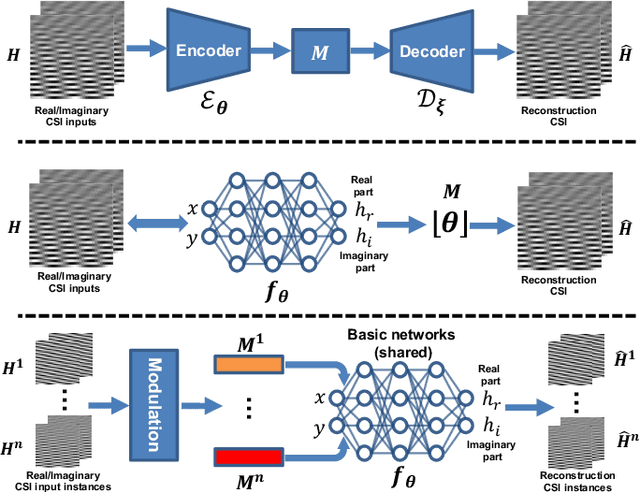
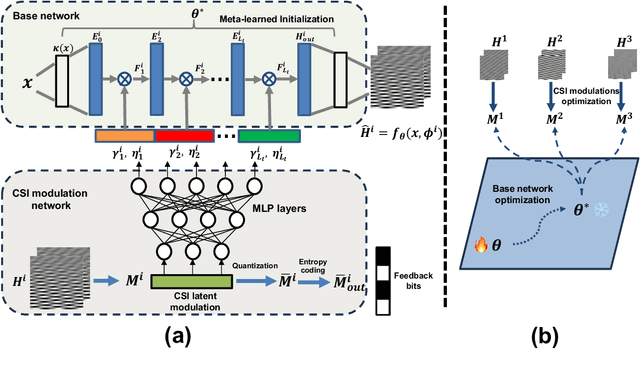
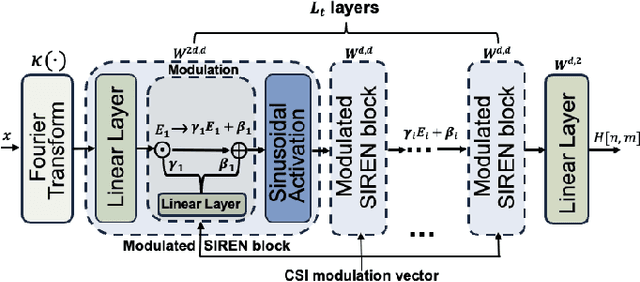
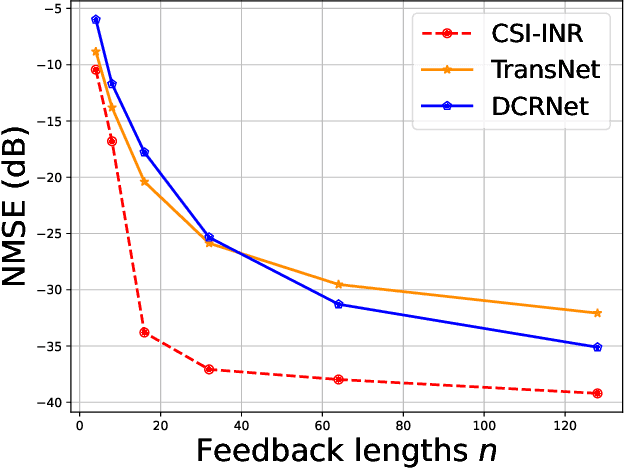
Abstract:Acquiring and utilizing accurate channel state information (CSI) can significantly improve transmission performance, thereby holding a crucial role in realizing the potential advantages of massive multiple-input multiple-output (MIMO) technology. Current prevailing CSI feedback approaches improve precision by employing advanced deep-learning methods to learn representative CSI features for a subsequent compression process. Diverging from previous works, we treat the CSI compression problem in the context of implicit neural representations. Specifically, each CSI matrix is viewed as a neural function that maps the CSI coordinates (antenna number and subchannel) to the corresponding channel gains. Instead of transmitting the parameters of the implicit neural functions directly, we transmit modulations based on the CSI matrix derived through a meta-learning algorithm. Modulations are then applied to a shared base network to generate the elements of the CSI matrix. Modulations corresponding to the CSI matrix are quantized and entropy-coded to further reduce the communication bandwidth, thus achieving extreme CSI compression ratios. Numerical results show that our proposed approach achieves state-of-the-art performance and showcases flexibility in feedback strategies.
UAVD4L: A Large-Scale Dataset for UAV 6-DoF Localization
Jan 11, 2024Abstract:Despite significant progress in global localization of Unmanned Aerial Vehicles (UAVs) in GPS-denied environments, existing methods remain constrained by the availability of datasets. Current datasets often focus on small-scale scenes and lack viewpoint variability, accurate ground truth (GT) pose, and UAV build-in sensor data. To address these limitations, we introduce a large-scale 6-DoF UAV dataset for localization (UAVD4L) and develop a two-stage 6-DoF localization pipeline (UAVLoc), which consists of offline synthetic data generation and online visual localization. Additionally, based on the 6-DoF estimator, we design a hierarchical system for tracking ground target in 3D space. Experimental results on the new dataset demonstrate the effectiveness of the proposed approach. Code and dataset are available at https://github.com/RingoWRW/UAVD4L
A Unitary Weights Based One-Iteration Quantum Perceptron Algorithm for Non-Ideal Training Sets
Sep 23, 2023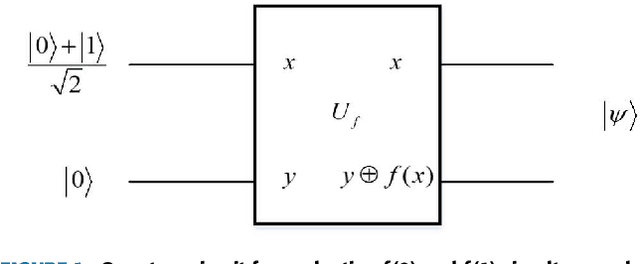
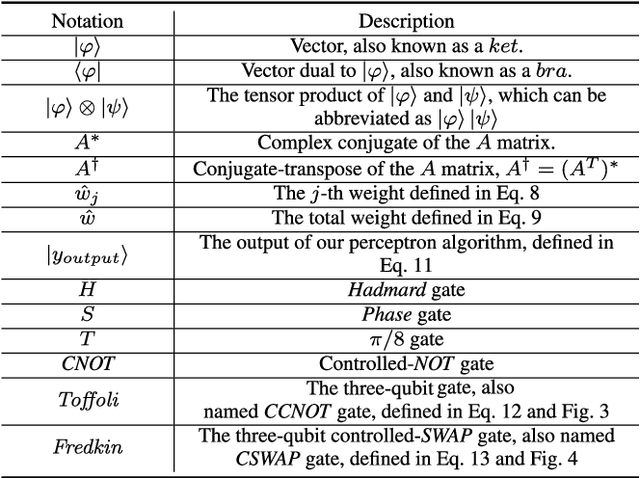
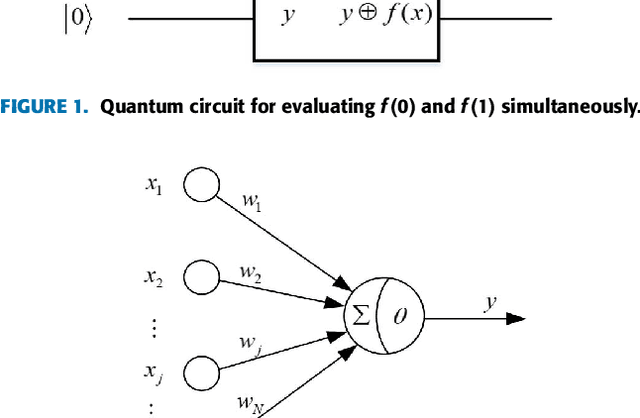
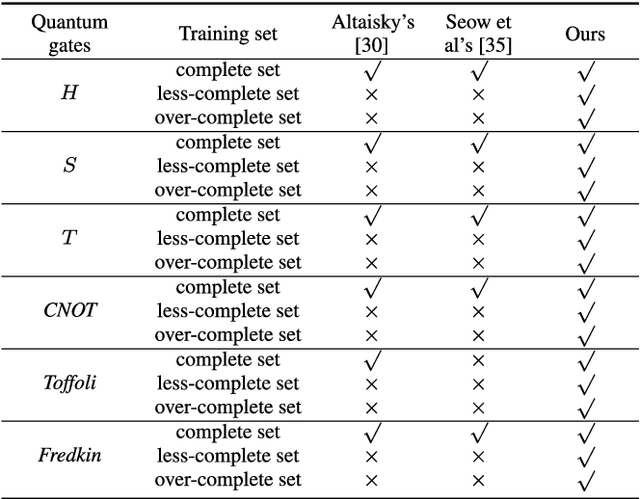
Abstract:In order to solve the problem of non-ideal training sets (i.e., the less-complete or over-complete sets) and implement one-iteration learning, a novel efficient quantum perceptron algorithm based on unitary weights is proposed, where the singular value decomposition of the total weight matrix from the training set is calculated to make the weight matrix to be unitary. The example validation of quantum gates {H, S, T, CNOT, Toffoli, Fredkin} shows that our algorithm can accurately implement arbitrary quantum gates within one iteration. The performance comparison between our algorithm and other quantum perceptron algorithms demonstrates the advantages of our algorithm in terms of applicability, accuracy, and availability. For further validating the applicability of our algorithm, a quantum composite gate which consists of several basic quantum gates is also illustrated.
* 12 pages, 5 figures
 Add to Chrome
Add to Chrome Add to Firefox
Add to Firefox Add to Edge
Add to Edge